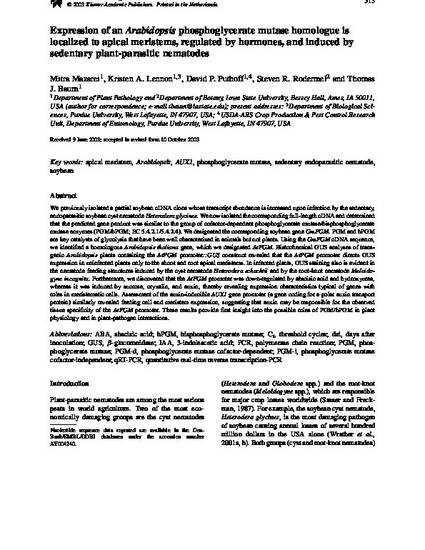
We previously isolated a partial soybean cDNA clone whose transcript abundance is increased upon infection by the sedentary, endoparasitic soybean cyst nematode Heterodera glycines. We now isolated the corresponding full-length cDNA and determined that the predicted gene product was similar to the group of cofactor-dependent phosphoglycerate mutase/bisphosphoglycerate mutase enzymes (PGM/bPGM; EC 5.4.2.1/5.4.2.4). We designated the corresponding soybean gene GmPGM. PGM and bPGM are key catalysts of glycolysis that have been well characterized in animals but not plants. Using the GmPGM cDNA sequence, we identified a homologous Arabidopsis thaliana gene, which we designatedAtPGM. Histochemical GUS analyses of transgenic Arabidopsis plants containing theAtPGMpromoter::GUS construct revealed that the AtPGM promoter directs GUS expression in uninfected plants only to the shoot and root apical meristems. In infected plants, GUS staining also is evident in the nematode feeding structures induced by the cyst nematode Heterodera schachtii and by the root-knot nematode Meloidogyne incognita. Furthermore, we discovered that the AtPGM promoter was down-regulated by abscisic acid and hydroxyurea, whereas it was induced by sucrose, oryzalin, and auxin, thereby revealing expression characteristics typical of genes with roles in meristematic cells. Assessment of the auxin-inducible AUX1 gene promoter (a gene coding for a polar auxin transport protein) similarly revealed feeding cell and meristem expression, suggesting that auxin may be responsible for the observed tissue specificity of the AtPGM promoter. These results provide first insight into the possible roles of PGM/bPGM in plant physiology and in plant-pathogen interactions.
Available at: http://works.bepress.com/thomas-baum/15/

This article is published as Mazarei, Mitra, Kristen A. Lennon, David P. Puthoff, Steven R. Rodermel, and Thomas J. Baum. "Expression of an Arabidopsis phosphoglycerate mutase homologue is localized to apical meristems, regulated by hormones, and induced by sedentary plant-parasitic nematodes." Plant molecular biology 53, no. 4 (2003): 513-530.